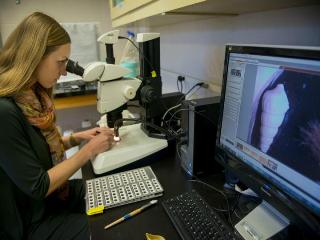Mar 31 2015
A 30-foot-long core sample of Pacific Ocean seafloor is changing what we know about ocean resiliency in the face of rapidly changing climate. A new study reports that marine ecosystems can take thousands, rather than hundreds, of years to recover from climate-related upheavals.
 At the UC Davis Bodega Marine Laboratory, Sarah Moffitt examines fossils within a marine sediment core. Credit:© Joe Proudman, UC Davis
At the UC Davis Bodega Marine Laboratory, Sarah Moffitt examines fossils within a marine sediment core. Credit:© Joe Proudman, UC Davis
The study's authors--including Peter Roopnarine, PhD, of the California Academy of Sciences--analyzed thousands of invertebrate fossils to show that ecosystem recovery from climate change and seawater deoxygenation might take place on a millennial scale. The revolutionary study is the first of its kind, and is published today in the Early Edition of the journal PNAS.
The scientific collaborative--led by Sarah Moffitt, PhD, from the UC Davis Bodega Marine Laboratory and Coastal and Marine Sciences Institute--analyzed more than 5,400 invertebrate fossils, from sea urchins to clams, within a sediment core from offshore Santa Barbara, California.
"In this study, we used the past to forecast the future," says Roopnarine, Academy curator of invertebrate zoology and geology. "Tracing changes in marine biodiversity during historical episodes of warming and cooling tells us what might happen in years to come. We don't want to hear that ecosystems need thousands of years to recover from disruption, but it's critical that we understand the global need to combat modern climate impacts."
The tube-like sediment core is a slice of ocean life as it existed between 3,400 and 16,100 years ago, and provides a before-and-after snapshot of what happened during the last major deglaciation--a time of abrupt climate warming, melting polar ice caps, and expansion of low oxygen zones in the ocean. The new study documents how long it has historically taken for ecosystems to begin recovery following dramatic shifts in climate.
'Complex' invertebrates
Previous marine sediment studies reconstructing Earth's climatic history rely heavily upon simple, single-celled organisms called Foraminifera. This week's study explores multicellular life--in the form of invertebrates--in pursuit of a more complete picture of ocean ecosystem resilience during past periods of climate change.
"The complexity and diversity of a community depends on how much energy is available," says Roopnarine. "To truly understand the health of an ecosystem and the food webs within, we have to look at the simple and small as well as the complex. In this case, marine invertebrates give us a better understanding of the health of ecosystems as a whole."
The study's all-important sediment core revealed an ancient history of abundant, diverse, and well-oxygenated seafloor ecosystems, followed by a period of oxygen loss and warming that seems to have triggered a rapid loss of biodiversity. The study reports that invertebrate fossils are nearly non-existent during times of lower-than-average oxygen levels.
Moffitt emphasized the importance of using a large, 30-foot core sample from one portion of the seafloor, saying the team "cut it up like a cake" to analyze the full, unbroken record.
In periods of fewer than 100 years, oceanic oxygen levels decreased between 0.5 and 1.5 mL/L. Sediment samples during these periods show that relatively minor oxygen fluctuations can result in dramatic changes for seafloor communities.
'New normal' of rapid climate change
The study results suggest that future periods of global climate change may result in similar ecosystem-level effects with millennial-scale recovery periods. As the planet warms, scientists expect to see much larger areas of low-oxygen "dead zones" in the world's oceans.
"Folks in Oregon and along the Gulf of Mexico are all-too-familiar with the devastating impacts of low-oxygen ocean conditions on local ecosystems and economies," says Roopnarine. "We must explore how ocean floor communities respond to upheaval as we adapt to a 'new normal' of rapid climate change. We humans have to think carefully about the planet we are leaving for future generations."